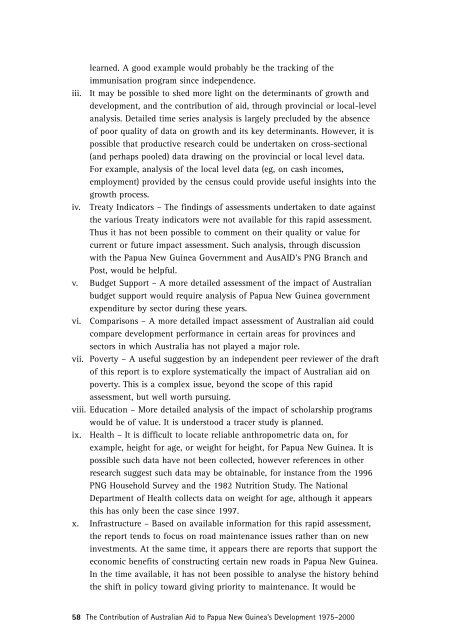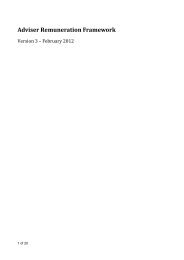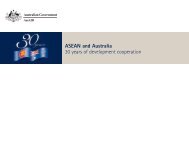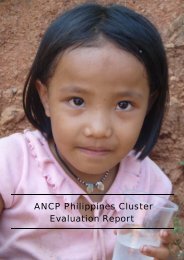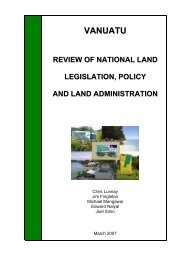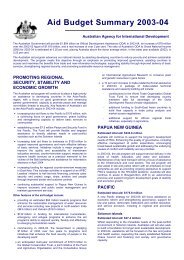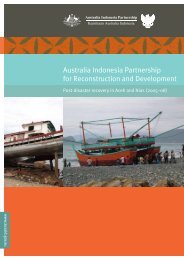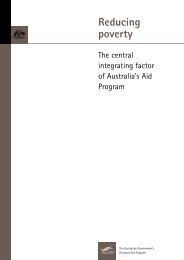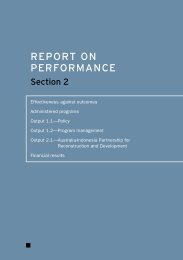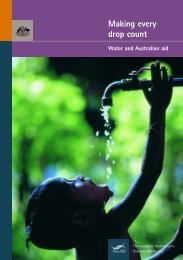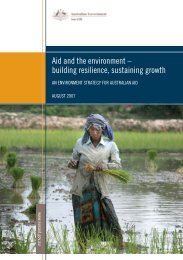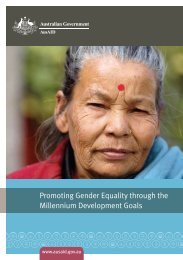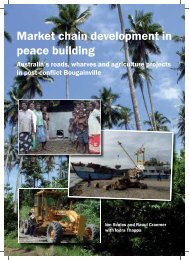Australian Aid to PNG - AusAID
Australian Aid to PNG - AusAID
Australian Aid to PNG - AusAID
You also want an ePaper? Increase the reach of your titles
YUMPU automatically turns print PDFs into web optimized ePapers that Google loves.
learned. A good example would probably be the tracking of theimmunisation program since independence.iii. It may be possible <strong>to</strong> shed more light on the determinants of growth anddevelopment, and the contribution of aid, through provincial or local-levelanalysis. Detailed time series analysis is largely precluded by the absenceof poor quality of data on growth and its key determinants. However, it ispossible that productive research could be undertaken on cross-sectional(and perhaps pooled) data drawing on the provincial or local level data.For example, analysis of the local level data (eg, on cash incomes,employment) provided by the census could provide useful insights in<strong>to</strong> thegrowth process.iv. Treaty Indica<strong>to</strong>rs – The findings of assessments undertaken <strong>to</strong> date againstthe various Treaty indica<strong>to</strong>rs were not available for this rapid assessment.Thus it has not been possible <strong>to</strong> comment on their quality or value forcurrent or future impact assessment. Such analysis, through discussionwith the Papua New Guinea Government and <strong>AusAID</strong>’s <strong>PNG</strong> Branch andPost, would be helpful.v. Budget Support – A more detailed assessment of the impact of <strong>Australian</strong>budget support would require analysis of Papua New Guinea governmentexpenditure by sec<strong>to</strong>r during these years.vi. Comparisons – A more detailed impact assessment of <strong>Australian</strong> aid couldcompare development performance in certain areas for provinces andsec<strong>to</strong>rs in which Australia has not played a major role.vii. Poverty – A useful suggestion by an independent peer reviewer of the draf<strong>to</strong>f this report is <strong>to</strong> explore systematically the impact of <strong>Australian</strong> aid onpoverty. This is a complex issue, beyond the scope of this rapidassessment, but well worth pursuing.viii. Education – More detailed analysis of the impact of scholarship programswould be of value. It is unders<strong>to</strong>od a tracer study is planned.ix. Health – It is difficult <strong>to</strong> locate reliable anthropometric data on, forexample, height for age, or weight for height, for Papua New Guinea. It ispossible such data have not been collected, however references in otherresearch suggest such data may be obtainable, for instance from the 1996<strong>PNG</strong> Household Survey and the 1982 Nutrition Study. The NationalDepartment of Health collects data on weight for age, although it appearsthis has only been the case since 1997.x. Infrastructure – Based on available information for this rapid assessment,the report tends <strong>to</strong> focus on road maintenance issues rather than on newinvestments. At the same time, it appears there are reports that support theeconomic benefits of constructing certain new roads in Papua New Guinea.In the time available, it has not been possible <strong>to</strong> analyse the his<strong>to</strong>ry behindthe shift in policy <strong>to</strong>ward giving priority <strong>to</strong> maintenance. It would be58 The Contribution of <strong>Australian</strong> <strong>Aid</strong> <strong>to</strong> Papua New Guinea’s Development 1975–2000


